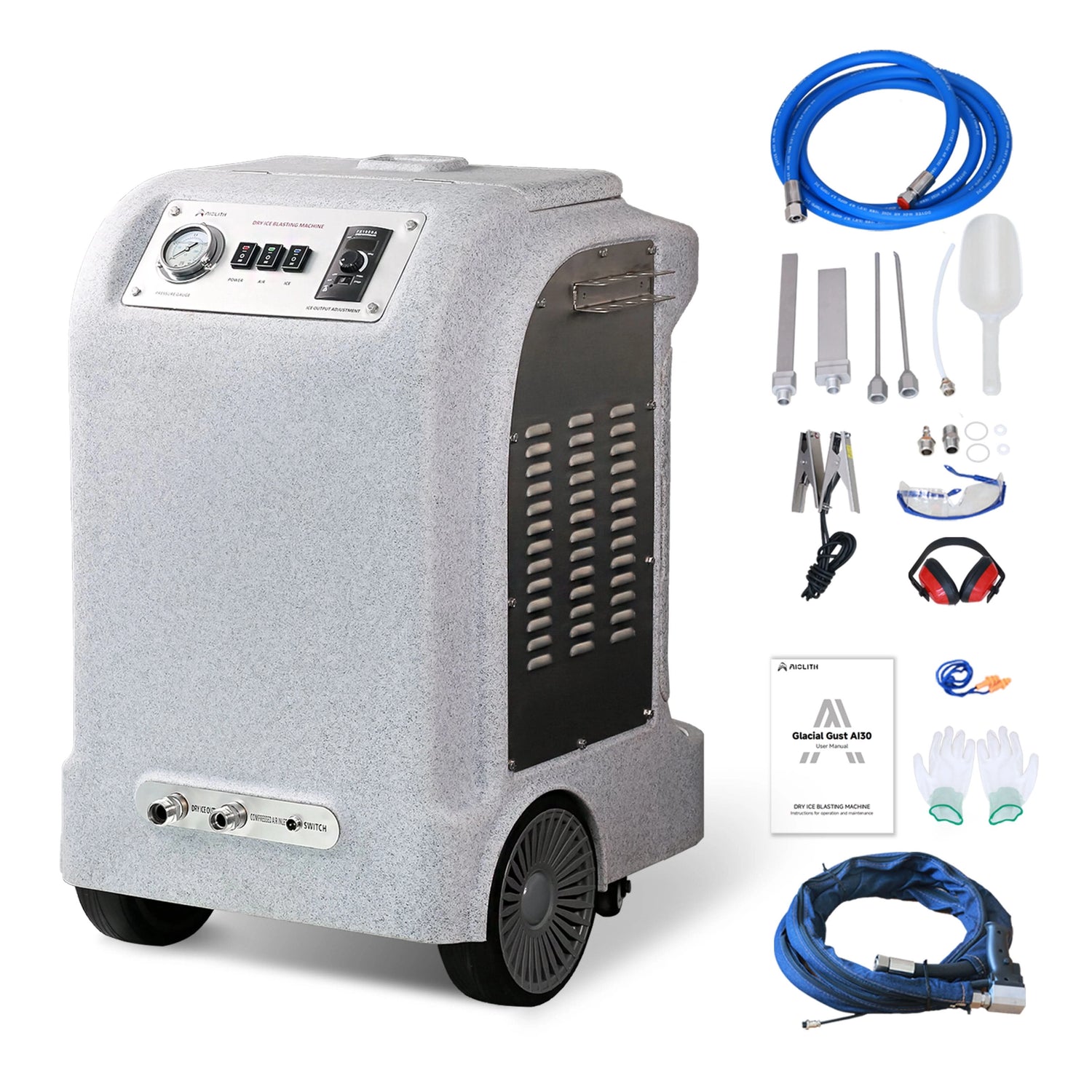7 Powerful Reasons Why Commercial Floor Cleaning Equipment is Revolutionizing Facility Maintenance in 2025
Share
Let’s be honest—cleaning large commercial floors is exhausting, slow, and expensive.
From warehouses to hospitals, many facilities still rely on manual cleaning or outdated machines that consume energy, labor hours, and water. The average cleaning cost per square foot has risen by 30% in the last five years (Facility Executive Report, 2024).
That’s where commercial floor cleaning equipment comes into play — especially advanced models like Aiolith’s industrial scrubbers, which deliver cleaner, faster, and smarter results while reducing operational costs dramatically.
Why Commercial Floor Cleaning Equipment Matters in 2025
Businesses today can’t afford inefficiency. In a fast-moving environment, clean floors are more than just hygiene—they’re brand reputation and safety. According to ISS World Services, cleanliness directly influences employee productivity and customer satisfaction.
Modern commercial floor cleaning machines combine power with precision. Whether in logistics centers, retail spaces, or airports, these machines ensure floors are spotless, dry, and safe within minutes—without wasting manpower or water.
The Real Pain Points: Labor, Cost, and Efficiency
| Pain Point | Traditional Cleaning | Modern Floor Cleaning Equipment |
|---|---|---|
| Labor Costs | Requires multiple staff | Operated by one person |
| Time Efficiency | Slow and inconsistent | Up to 5x faster |
| Cleaning Consistency | Manual errors common | Uniform performance |
| Energy Use | High and inefficient | Smart energy management |
| Water Consumption | Excessive use | Recycles and minimizes waste |
In surveys from the Cleaning Industry Research Institute (CIRI, 2023), over 68% of facility managers said labor shortages are their top concern. That’s where equipment like ride-on scrubbers from Aiolith step in—cutting manual workload while maintaining superior results.
What Makes Lithium Battery Floor Scrubbers a Game-Changer
Traditional lead-acid batteries are heavy, slow-charging, and costly to maintain. By contrast, lithium-ion batteries—like those in Aiolith’s machines—charge faster, last longer, and require almost no maintenance.
According to CleanLink Magazine, lithium battery scrubbers lower total operating costs by 70% over 5 years. That’s because they:
- Offer 4-hour full charging time
- Deliver up to 5 hours of continuous operation
- Eliminate costly acid maintenance
- Provide better energy density and consistent power
Inside Look: Aiolith Commercial Floor Scrubbers
Aiolith is a leader in industrial and commercial floor care technology, focusing on performance and sustainability. Their machines are designed for factories, airports, malls, and schools—anywhere where cleanliness meets efficiency.
With ergonomic design, smart sensors, and reliable lithium batteries, Aiolith scrubbers stand out for their balance between cost and performance.
Product Specifications: Aiolith Industrial Floor Scrubber (AF2225)
| Specification | Details |
|---|---|
| Working Width | 22" |
| Solution Tank | 23 gal |
| Recovery Tank | 25 gal |
| Max Capacity | 55,000 ft²/h |
| Battery Type | 24V/100AH Lithium |
| Charging Time | 4 Hours |
| Brush Pressure | 88 lbs |
| Brush RPM | 155 rpm |
| Brush Motor | 24V/550W |
| Suction Motor | 24V/500W |
| Turning Radius | 48" |
| Noise Level | 70 dB |
| Max Gradient | 18% |
This model delivers an optimal balance of power and agility, perfect for medium-to-large commercial spaces. Its splash guard and smart suction system ensure clean, dry floors instantly—reducing slip risks and water waste.
Comparing Traditional Cleaning vs. Modern Floor Scrubbers
Traditional mopping relies heavily on labor and is prone to inefficiency. In contrast, modern commercial floor cleaning equipment can clean ten times faster with 90% less water.
| Aspect | Manual Cleaning | Aiolith AF2225 |
|---|---|---|
| Cleaning Area (per hour) | 5,000 ft² | 55,000 ft² |
| Water Usage | 10 gallons/hour | 2 gallons/hour |
| Labor Needed | 3–4 workers | 1 operator |
| Downtime | Frequent | Minimal |
| Long-Term Cost | High | 70% lower |
Source: CleanLink, Cleaning Equipment Trade Association
Real Customer Feedback: Pain Points and Breakthroughs
| Customer Name | Industry | Pain Point | Feedback |
|---|---|---|---|
| Maria L. | Logistics | Manual mopping took too long | “Aiolith’s scrubber cut cleaning time by half!” |
| Dan W. | Retail | Noise during open hours | “The 70 dB quiet operation is perfect for stores.” |
| Kenta Y. | Manufacturing | High battery maintenance cost | “The lithium system saved us 60% in upkeep.” |
These stories mirror what thousands of facility managers face daily — inefficient cleaning and rising costs. With Aiolith’s lithium battery floor scrubbers, those pain points fade away.
How Lithium Technology Reduces 70% of Operating Costs

Using lithium-ion technology, Aiolith’s machines consume less energy, require less maintenance, and run longer. Over five years, total ownership costs (TCO) can drop up to 70%, according to the TCO Tool.
Here’s the breakdown:
| Cost Factor | Lead-Acid Scrubber | Aiolith Lithium Scrubber |
|---|---|---|
| Initial Purchase | $6,000 | $3500-6,000 |
| Battery Replacement | $2,000 every 2 years | None (10-year lifespan) |
| Maintenance | $1,200/year | $200/year |
| Total 5-Year Cost | $14,000 | $7,500 (≈47% less) |
Understanding TCO: The Smart Way to Measure Savings
Many companies only consider upfront costs when buying cleaning equipment. However, the Total Cost of Ownership (TCO) reveals the real value.
The TCO calculator demonstrates how lithium-powered machines dramatically reduce operating, maintenance, and downtime costs. It’s a must-use tool for any facility manager making long-term investment decisions.
How to Choose the Right Floor Scrubber for Your Business
If you’re unsure how to choose, Aiolith’s floor scrubber selection guide (link here) provides expert insights.
Key factors to consider:
- Floor Area: Measure total square footage.
- Surface Type: Concrete, tile, or epoxy determine brush choice.
- Power Source: Opt for lithium-ion over lead-acid for efficiency.
- Mobility: Choose between walk-behind or ride-on scrubbers.
- Noise Level: Indoor use requires quieter systems (≤70 dB).
Best Practices for Maintaining Commercial Cleaning Machines
- Charge lithium batteries properly to extend lifespan.
- Empty and rinse recovery tanks daily.
- Replace brushes periodically for consistent results.
- Store machines in a dry, ventilated area.
Regular maintenance ensures years of efficient service and protects your investment.
Common Mistakes to Avoid When Investing in Cleaning Equipment
- Choosing low-cost over long-term efficiency
- Ignoring TCO analysis
- Overlooking noise and ergonomic design
- Using the wrong type of detergent or brush
Avoiding these mistakes ensures you get the maximum ROI from your commercial cleaning system.
Future Trends: Automation, AI, and Sustainability in Cleaning
Automation is the future. By 2030, over 60% of cleaning operations are expected to use autonomous scrubbers (Forbes, 2024).
Emerging trends include:
- AI-driven navigation systems
- Water-recycling technology
- Cloud-based performance monitoring
- Eco-friendly lithium energy solutions
FAQs
1. What is commercial floor cleaning equipment?
It’s specialized machinery designed to clean large indoor surfaces efficiently, saving time and reducing labor costs.
2. Why choose Aiolith scrubbers?
Aiolith offers durable, lithium-powered scrubbers that reduce operational costs and improve cleaning efficiency.
3. How much can I save using lithium-ion technology?
Up to 70% in total costs over five years, based on TCO data.
4. Is lithium-ion safer than lead-acid batteries?
Yes, lithium systems are maintenance-free, non-corrosive, and more environmentally friendly.
5. Where can I calculate my potential savings?
Use the TCO calculator to evaluate cost benefits accurately.
References
Facility Executive Report, 2024

